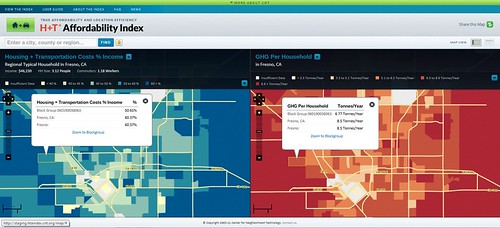Nationwide data show how transportation costs hurt families, better planning can help

Posted February 28, 2012 at 4:41PM
The Chicago-based Center for Neighborhood Technology maintains a massive, geocoded database of location-specific information on average housing costs, driving rates, transportation costs, and transportation-related greenhouse gas emissions. The online, interactive Housing + Transportation Affordability Index, as it is called, is both highly useful in allowing comparisons of typical household costs in different locations and highly revealing as it illuminates the benefits of close-in, walkable neighborhoods in bringing those costs down. And, as of today, the Index has become even more sophisticated and robust.
When CNT expanded the extensively mapped database in 2010 from 55 to 337 metro areas across the country, I called the accompanying report the “most important analysis of land use you’ll see all year.” It demonstrated that houses in sprawling subdivisions can effectively be more expensive than they seem, because for the average household they require so much driving to accomplish daily tasks that high transportation costs can wipe out the perceived savings from what may seem to be a bargain home purchase price.
How the Index works
CNT has now expanded the Index to some 900 metropolitan and “micropolitan” areas covering 89 percent of the American population. (Under the US Census, metropolitan areas have populations exceeding 50,000 people; micropolitan areas have populations between 10,000 and 50,000.) The aggregate data show that 72 percent of communities covered in the system have combined housing and transportation costs that under standard formulas would be considered unaffordable for typical families, when median regional household income is compared to average housing and transportation costs. Locations become more affordable, however, in neighborhoods with close access to amenities, jobs, and transit.
 To illustrate, I used the database’s interactive maps to navigate randomly to the Rapid City, South Dakota area, where the median household income is $45,318 per year and median household size is 2.43 people. I used the map to look at a location on the south side of town and learned that an average home on the block I selected costs 26 percent of median household income, an amount under the 30 percent threshold generally considered affordable. But, given average driving rates for the location, the costs of housing and transportation considered together amount to 56 percent of median income, imposing a significant burden on the typical family. I also learned that the average household in the vicinity generates over 8.6 tons per year of greenhouse gas emissions from transportation.
To illustrate, I used the database’s interactive maps to navigate randomly to the Rapid City, South Dakota area, where the median household income is $45,318 per year and median household size is 2.43 people. I used the map to look at a location on the south side of town and learned that an average home on the block I selected costs 26 percent of median household income, an amount under the 30 percent threshold generally considered affordable. But, given average driving rates for the location, the costs of housing and transportation considered together amount to 56 percent of median income, imposing a significant burden on the typical family. I also learned that the average household in the vicinity generates over 8.6 tons per year of greenhouse gas emissions from transportation.
By comparison, I found residential neighborhoods closer to downtown where housing-only costs were still in the affordable range but where superior accessibility (proximity to jobs and other typical travel destinations) brought the costs of transportation down to an affordable level as well. Average greenhouse gas emissions per household in the most accessible neighborhoods were between 5.1 and 6.5 tons per year, a significant reduction from those of the first location. (Research shows that, among land use factors, proximity to typical destinations is the single most important determinant of how much people drive.)
(For a detailed, real-world comparison of CNT transportation and affordability data for four specific locations scattered across the Washington, DC metro region, go here.)
Implications and uses
Analyzing its current data in aggregate, CNT found that, between 2000 and 2009, US transportation and housing costs increased at nearly twice the rate of incomes. If you’re feeling squeezed, no wonder. But the good news, the organization reports,  is that people living in “location efficient” neighborhoods—those with good access to transit, jobs, and amenities—experienced only half the increase in transportation costs ($1,400/year) of those living in car-dependent places ($3,900/year).
is that people living in “location efficient” neighborhoods—those with good access to transit, jobs, and amenities—experienced only half the increase in transportation costs ($1,400/year) of those living in car-dependent places ($3,900/year).
For a policy analyst, the beefed-up Index is extremely useful and versatile. You can navigate to maps and data showing, in addition to the items already mentioned, average auto ownership and driving rates per household; average transit ridership; greenhouse gas emissions per acre as well as per household; residential density; average block size; percentages of owner-occupied and renter-occupied homes; and more, at an impressive level of detail. The maps are all color-coded, highlighting the differences among locations, and can be compared side-by-side.
I am also a huge fan of a related online tool called Abogo, developed by CNT a few years ago. It works something like Walk Score: enter an address and you are shown data revealing transportation costs and/or transportation-related carbon emissions for an average household in the vicinity, in each case compared to the average for the metro region as a whole.
The potential uses of the Index for public officials are many. The federal Department of Housing and Urban Development, for example, announced in 2010 that it would begin using location efficiency data, as well as the criteria embedded in the LEED for Neighborhood Development rating system, to assist its evaluation of grant applications. This allows the agency to assess locations where its housing dollars might be leveraged to produce the most affordability benefit. At the local government level, officials can use the data to assist zoning and investment practices to maximize the benefits for their residents. Lawmakers seeking to provide relief to strapped households – as well as to consider measures to address carbon emissions – can see that, in many locations, transportation remedies are needed as much as, if not more than, housing-cost remedies.
Along those lines, what really stood out from my experiment with Rapid City was the vast size of the area that suffered from high household costs when housing and transportation were combined, and how little of the region seemed comfortably affordable to average working families. If that isn’t a policy concern, it should be.
Moreover, it is not just the public sector that can benefit from the information revealed by the Index. In commenting on a blog post, land use analyst Laurence Aurbach stressed how useful the Index can be to everyone involved in homebuying:
“This is the type of information that should be prominent on every house that's for sale, just like an Energy Star sticker on a refrigerator. [There should be] disclosure of full locational costs for the buyer, banker, broker, and everyone else who has a stake in the affordability of a home. [There should be] disclosure of full greenhouse impacts for planners, engineers, utilities, and everyone else who has an interest in the environmental impacts of dwellings and urban form.”
A bit of history
Back in the early 1990s, my NRDC colleague (and MacArthur laureate-to-be) David Goldstein, an energy scientist, began working with consulting analyst John Holtzclaw to study the relationship of driving rates to household locations. Both based in San Francisco,  they had access to California data gleaned from vehicle odometers at smog-check inspections, which they correlated with vehicle registration data. They had a notion that people living in city locations would have lower driving rates, and thus consume less transportation energy and spend less on transportation, than those living in suburban sprawl. The results were eye-opening: for every doubling of neighborhood residential density, there was a 25-30 percent reduction in driving per household.
they had access to California data gleaned from vehicle odometers at smog-check inspections, which they correlated with vehicle registration data. They had a notion that people living in city locations would have lower driving rates, and thus consume less transportation energy and spend less on transportation, than those living in suburban sprawl. The results were eye-opening: for every doubling of neighborhood residential density, there was a 25-30 percent reduction in driving per household.
They soon partnered with CNT and with the Surface Transportation Policy Project, and the three organizations began to pursue the research in earnest, producing an important peer-reviewed study in 2002. The partners called their concept “location efficiency” and developed a market benefit called the “location-efficient mortgage,” which allowed lenders to consider the reduced transportation costs associated with dense urban locations in determining homebuyers’ eligibility for loans.
As it turned out, that was just the beginning. Scott Bernstein, Jacky Grimshaw, Peter Haas and their able colleagues at CNT have since invested substantial resources in the concept, the research, and the policy applications. They have taken the Housing + Transportation Affordability Index to a level that none of us even imagined back in the day, and the rest of us are continually grateful for their leadership and skill.
Move your cursor over the images for credit information.
Please also visit NRDC’s Sustainable Communities Video Channel.

